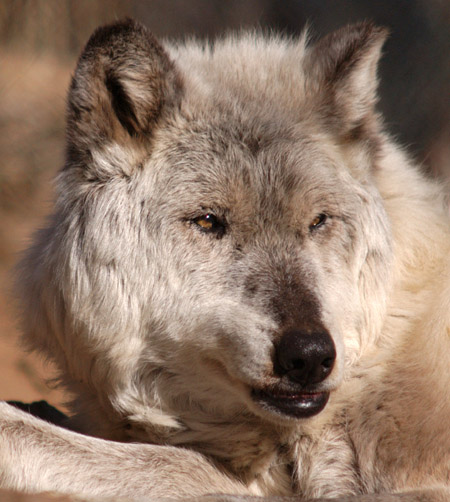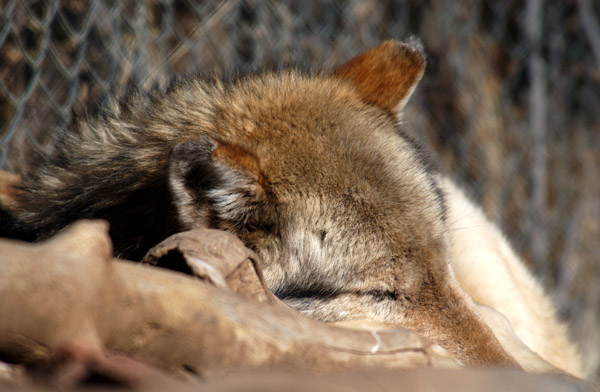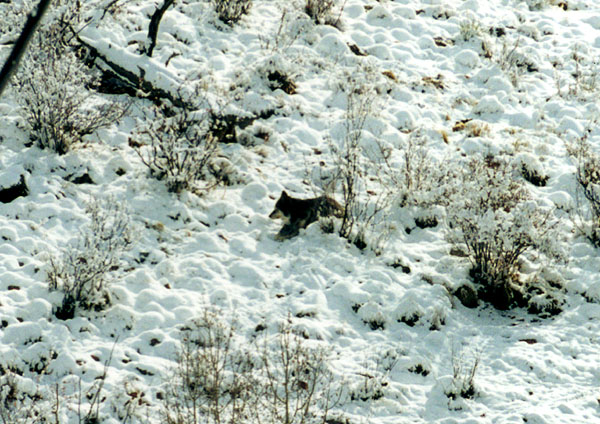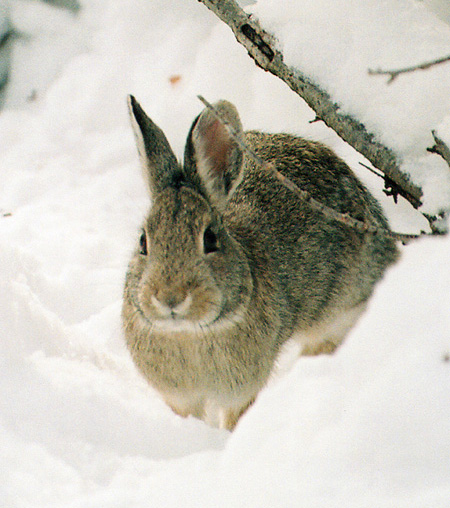The Weekly Wolf
I spent six years living with the wolves of
Mission:Wolf.
Each Monday, this page will feature a new photograph and story of these wolves.
December 27, 2010

Jordan
Jordan was a shy black female wolf born May 2, 1987 on a dairy farm in Wisconsin. Thankfully she and two of her siblings, sister Raven and brother Lucus, were rescued before they could be sold as pets and came to live at Mission:Wolf when only seven weeks old.
As a pup, Jordan had an overbite that left one of her fangs protruding up from her lip. This trademark earned her the nickname of “Snaggletooth.” For years, Jordan was the leader who never led. She had all the ambition and strength of an alpha, yet she was always the underling. Though subordinate, Jordan played an intriguing and cunning role in the history of her pack. When her sister Raven overthrew their pack mate Cyndar and became alpha female, it was only because of Jordan's assistance that she succeeded. Then, with an eerie similarity, Jordan helped Raven's daughter Nyati dominate Raven and gain the alpha position.
Due to Nyati’s dominant personality, Jordan was forced to keep her tail tucked and act as the pack’s omega. However, she had no problem getting right in the middle of things at feeding time… running up to the fence, bounding off and doing back flips in the air while catching meat. Her role as omega allowed her to watch her pack-mates’ rivalries without serious injury to herself. However, as Jordan began to hobble with age, Nyati continued to harass her during breeding season. We were worried that Nyati would cause a serious injury to an elder Jordan, and so separated them.
Finally the alpha female of her own pack, Jordan lived with a male wolf named Nikkolah for the last few years of her life, until her long-time companion passed away in the summer of 2003. As time went on, Jordan’s black coat turned silvery-gray, but she kept all of her caretakers on their toes. Whenever the staff entered her enclosure to clean her water bucket, Jordan tried to chase us around, only to miss biting our shoes by a couple of inches because of her failing eyesight.
Eventually Jordan was moved to the Mission:Wolf farm due to health problems. She spent the next three years getting daily massages and attention from Kent. When she finally passed away on a quiet January morning in 2005, Jordan was 17 years old and was still the alpha of her pack. She will forever be remembered for her mealtime acrobatics and her tenacious spirit.
December 20, 2010

Nikkolah
Nikkolah, often times known as "Tricky Nikki," arrived at Mission:Wolf in the summer of 1987. He was born in a Florida backyard as the result of an accidental litter. At the age of six weeks, he and his four brothers were transported to Colorado to create a wildlife center near Durango. Two brothers stayed at the center, two brothers were given to individual owners and Nikki came to live at Mission:Wolf when only nine weeks old. We had already accepted six other pups when Nikki came along, so it made little difference if we took in one more.
Nikki grew up and lived with his adopted littermates, exploring the refuge freely as puppies while we built large enclosures. Within a year we were saddened to learn that all four of Nikki's true brothers were dead - all were killed when they escaped their confinement and were shot, a demise that happens to many captive wolves and wolf-dogs. Nikki soon settled into the role of the beta male in his pack, and for 14 years of his life looked up to his leader Lucus. His pack varied over time from four to eleven wolves. As he and his adopted siblings aged, some of the rivals were given new enclosures, leaving Nikki in with Lucus, Raven, Nyati and Jordan. He earned his nickname “Tricky Nikki” when he climbed over the fence separating the boys from the girls during breeding season and became the father of one of the only litters of pups to be born at the refuge.
When they reached the age of fourteen, he and his life-long partner Jordan were given their own enclosure in which to live free of the pressure and competition for food that occurs with a larger pack. Nikki and Jordan spent a happy year hobbling around their enclosure showing off to Nyati and Lucus through the fence. However, in early May 2003, we went to check on sixteen year old Jordan who has having a hard time moving around. We found Jordan growling at Nyati as usual, but Nikki was paralyzed in the hips. Within a few days he faded and, with tears in our eyes, we helped Nikki pass over on May 7, 2003. He was one of the most impressive wolves I’ve ever seen. Nikki was one of the last surviving buffalo wolves – one of the largest subspecies of wolves that lived on the Great Plains and specialized in hunting bison.
December 13, 2010

Uncle Bowdi
In the Spring of 1992, Mission:Wolf received a call from a Montana wolf breeder about rescuing three pups that were to be euthanized if no home was found. Hearing the plight of these animals, Mission:Wolf staff pooled their personal funds for gas money and food. Two dedicated volunteers then set off for Montana the next day. They returned to the refuge with three timid black puppies who had brilliant wild eyes. The two females were named Hina and Jazmine, while the little boy with a bright white patch on his chest became known as Bowdi.
Bowdi soon grew to be the largest wolf living at the refuge, at 142 lbs. Although his body was huge, he still had the attitude of a puppy. He was a bit clumsy, yet had such enormous strength that he could be quite intimidating. As a yearling, he towered above the other wolves and took advantage of his size during dinner time. Otherwise, Bowdi remained one of the most fun loving, playful and carefree wolves to live at Mission:Wolf.
In 1993, Bowdi's sister Jazmine gave birth to a litter of pups. Whenever the youngsters got out of control the adult wolves in the pack would jump up, scold the pups and run away, opting for peace and quiet. However, "Uncle" Bowdi put up with the constant barrage of energy from his three nieces and nephew, exhibiting inexhaustible patience. He put up with the wild pups’ obnoxious roughhousing for hours, as they made him whimper while tugging on his ears, cheeks and tail. He just laid there, his eyes peering out as if to say "Why me?" while the pups played and practiced their chewing skills.
Uncle Bowdi spent many years overlooking the refuge from his rocky outcrop with Jazmine. I never got to meet Bowdi up close because he always remained shy around new people, but his sheer size and straightforward, powerful gaze was impressive even at a distance. He passed away in May 2001 from natural causes, but we still tell the story of Uncle Bowdi to new volunteers and visitors – the big wolf with an even bigger heart.
December 6, 2010

Mountain Cottontail
Mountain Cottontails (Sylvilagus nuttallii) abound at Mission:Wolf and throughout the intermountain West. These furry little guys are most commonly seen foraging on native grasses, sagebrush and junipers in the Rocky, Cascade and Sierra-Nevada mountain ranges. They are a medium sized rabbit, weighing 1.5 – 2.5 lbs, with pale brown fur on their back and head, white underbellies, and large tails that are dark on top and white underneath. The Mountain Cottontail can be distinguished from the Desert Cottontail and the Eastern Cottontail by their relatively shorter ears with rounded, black tips.
As a rule Mountain Cottontails are solitary animals, due to the large amount of land needed to provide adequate shelter and food for each rabbit. Mating season, anytime between February and July depending on the climate, is the only time Cottontails usually socialize. After a short courtship, the female builds a cup-like nest lined with fur and dried grass. After only 30 days of gestation she gives birth to 4-6 young, and spends the next month raising them. Mountain Cottontails, like all rabbits, can be very prolific when the opportunity presents itself, producing 2-5 litters each year.
I took this photo of a Mountain Cottontail right in front of the Mission:Wolf staff kitchen. Unlike the rest of their species, Cottontails at the refuge have grown very bold and can be quite the little socialites. Since the presence of the humans scares away other potential predators (i.e. bobcats, coyotes, martens, owls, hawks, and eagles) and the captive wolves cannot get to them, the refuge’s rabbit population has exploded. All winter long you can watch the heroic antics of the Mountain Cottontails as they leap, bound and chase each other around in their courtship dances. Then in the spring and summer the adorable babies emerge from their nests and manage to draw even more attention from visitors than the wolves. I sometimes suspected that the wolves conspired to get their revenge on the attention-stealing Cottontails by chasing, mauling and eating one of the baby rabbits right in front of a group of particularly impressionable children… after the ensuing shrieks the discussion inevitably turned to the circle of life and how every living thing in an ecosystem depends on all the others for their survival.
